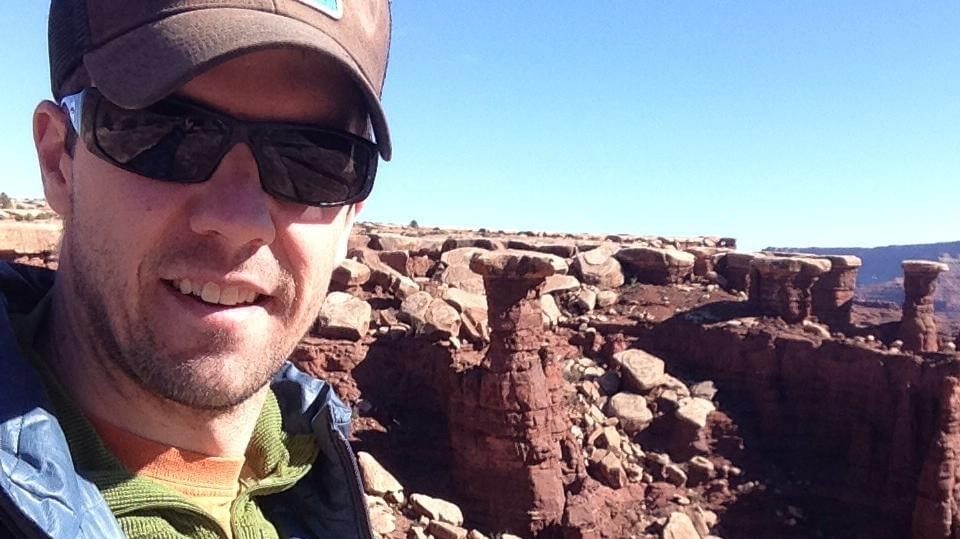Some information may be outdated.
Ray Mesa, near the La Sal mountains on the Colorado-Utah border is notable for its old-growth ponderosa pines (estimated to be several hundred years old) that are growing in cool drainages amongst pinyon-juniper woodlands. Recent ponderosa tree mortality raised concerns among land managers and Larissa Yocom, a fire ecologist at Utah State University, began exploring the potential causes of these deaths.

Science Moab: Ray Mesa is east of the town of La Sal, near the Colorado-Utah border. The ponderosas you are looking at are surrounded by pinyon-juniper forest. Why are ponderosas growing in that area?
Yocom: It’s a really interesting place because the ponderosa pines are growing in drainages. Most of the mesa is pinyon and juniper, but the ponderosas are growing in these cold air drainages, where the cold air provides them just enough of what they need climate-wise for them to thrive. So they’re actually growing at a lower elevation than the mesa around them.
Science Moab: How old do you estimate some of these stands are?
Yocom: They are several hundred years old, probably 300 or 400 at least, and maybe even older. We weren’t able to get an age on the centers of the biggest trees, but at least a few hundred years old.
Science Moab: What made you want to study these trees?
Yocom: The Bureau of Land Management has been managing these old ponderosa stands to try to keep them alive and healthy and they noticed that there was some mortality. So they were wondering if there was a way we could look into what was causing those old trees to die, because that’s not what they want to see happening out there.
Science Moab: What are some of the reasons these trees are dying?
Yocom: One of them is drought. There has been a lot of drought in that area over the last couple of decades, and that’s been cited as a cause for mortality, or, death, for some old trees in other places around the southwestern US. Insect attacks can also impact trees, and we also thought about the lack of fire over the past 140 years.
Without fire, you can get an increase in competition from pinion and juniper moving into these drainages. More frequent historic fires would have kept out that competition. One of our hypotheses was that perhaps with the absence of fire, more competition means less availability of water and other resources for these old trees.
We found plenty of evidence of insect attack, and we saw pretty low growth in a lot of these areas and a good amount of competition, especially where those stands have not been thinned out recently. Then we also found that the managers have been doing prescribed fires to try to increase the resilience and resistance of these old trees to [stressors] like drought and insects. In a couple places, those prescribed fires got too hot and those were likely the actual direct cause of death of a few of the trees that we documented.
Science Moab: If fire is good for these stands of ponderosas, how can a fire become too hot, to the point where it actually damages the tree?
Yocom: That also probably has to do with how long it’s been since there was a fire in that area. The last, more frequent fires were in about 1880; that’s a long time for fuel to build up around the base of these trees. In some places we could see more than a foot of pine needles had piled up, so then with the reintroduction of fire, that kind of material can burn for hours or even days, and eventually the heat can get through even the really thick bark of ponderosas and kill the trees’ living tissues.
Science Moab: Logistically, how did you go about studying these stands of trees?
Yocom: We looked for every old growth ponderosa pine tree in four areas (two areas treated with prescribed fire, and two untreated areas) and we documented whether each tree was alive or dead and whether it had any sign of insect damage and any other notes. We also took tree cores from each to measure their growth; that’s done with a hollow drill type instrument, and you can take a pencil-sized core of wood out of the tree and look at how fast it’s been growing over the years as long as you can see the tree’s rings. We also took samples where we identified trees that had recorded fires in their rings. We also looked at satellite imagery and because the trees’ canopies are so big, we could actually see approximately when different trees had died.
Science Moab: How is the BLM going to proceed after learning all this information?
Yocom: Hopefully they will continue to do prescribed fire. I think it is really helpful, as shown by the trees that did survive—they’re doing better now after these treatments. It was a pretty small percentage of trees that were negatively impacted by the prescribed fires, so I think it’s still worth doing them. Trying to remove some of the fuel around these old trees before [doing] a burn should help. I think [the BLM] is glad to know that prescribed fire is useful, but that care needs to be taken to try their best to protect these old trees.
Appreciate the coverage? Help keep local news alive.
Chip in to support the Moab Sun News.





